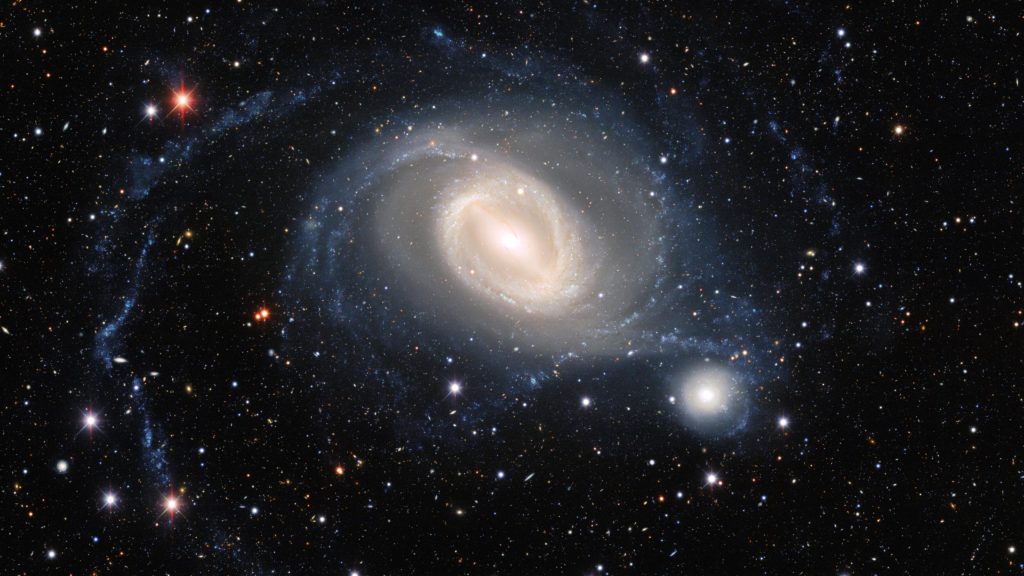

The interactive pair of galaxies NGC 1512 and NGC 1510 take center stage in this image from the Dark Energy Camera, the latest wide-field imager on the Víctor M. Blanco 4-meter Telescope at the Cerro Tololo Inter-American Observatory, NSF’s NOIRLab program. NGC 1512 has been in the process of merging with its smaller galactic neighbor for 400 million years, and this long-term interaction has sparked waves of star formation and distorted both galaxies. Credit: Dark Energy Survey/DOE/FNAL/DECam/CTIO/NOIRLab/NSF/AURA, Image processing: TA Rector (University of Alaska Anchorage/NSF’s NOIRLab), J. Miller (Gemini Observatory/NSF’s NOIRLab), M. De Martin ( NSF’s NOIRLab)
The Department of Energy-funded Dark Energy Camera at NSF’s NOIRLab in Chile captures a pair of galaxies performing a gravitational binocular.
The interactive galaxy pair NGC 1512 and NGC 1510 take center stage in this image from the US Department of Energy’s Dark Energy Camera, the latest 570-megapixel wide-field imaging on the Víctor M. Blanco 4 meter telescope at the Cerro Tolo Inter-American Observatory, It is an affiliate program of NSF NOIRLab. NGC 1512 has been in the process of merging with its smaller galactic neighbor for 400 million years, and this long-term interaction has sparked waves of star formation.
The barred spiral galaxy NGC 1512 (left) and its small galaxy NGC 1510 in this observation (image at the top of the article) were captured by the 4 meter Víctor M. Blanco Telescope. In addition to revealing the complex internal structure of NGC 1512, this image shows the galaxy’s faint outer tendrils extending and appearing to surround its small companion. The stream of starry light that connects the two galaxies is evidence of their gravitational interaction – a luxurious and graceful connection that has lasted for 400 million years. The gravitational interaction between NGC 1512 and NGC 1510 has affected the rate of star formation in both galaxies as well as distorting their shapes. Finally, NGC 1512 and NGC 1510 will merge into a single larger galaxy – a lengthy example of galactic evolution.

Wider crop of NGC 1512 image. Credit: Dark Energy Survey/DOE/FNAL/DECam/CTIO/NOIRLab/NSF/AURA, Image processing: TA Rector (University of Alaska Anchorage/NSF’s NOIRLab), J. Miller (Gemini Observatory/NSF’s NOIRLab) , M. de Martin (NSF’s NOIRLab)
These interacting galaxies are located in the direction of the constellation Horologium in the southern celestial hemisphere and are approximately 60 million light-years from Earth. The wide field of view of this observation shows not only the tangled galaxies, but also their starry surroundings. The frame is full of bright front stars inside[{” attribute=””>Milky Way and is set against a backdrop of even more distant galaxies.
The image was taken with one of the highest-performance wide-field imaging instruments in the world, the Dark Energy Camera (DECam). This instrument is perched atop the Víctor M. Blanco 4-meter Telescope and its vantage point allows it to collect starlight reflected by the telescope’s 4-meter-wide (13-foot-wide) mirror, a massive, aluminum-coated, and precisely shaped piece of glass roughly the weight of a semi truck. After passing through the optical innards of DECam — including a corrective lens nearly a meter (3.3 feet) across — starlight is captured by a grid of 62 charge-coupled devices (CCDs). These CCDs are similar to the sensors found in ordinary digital cameras but are far more sensitive, and allow the instrument to create detailed images of faint astronomical objects such as NGC 1512 and NGC 1510.

An even wider crop of the NGC 1512 image. Credit: Dark Energy Survey/DOE/FNAL/DECam/CTIO/NOIRLab/NSF/AURA, Image processing: T.A. Rector (University of Alaska Anchorage/NSF’s NOIRLab), J. Miller (Gemini Observatory/NSF’s NOIRLab), M. Zamani & D. de Martin (NSF’s NOIRLab)
Large astronomical instruments such as DECam are custom-built masterpieces of optical engineering, requiring enormous effort from astronomers, engineers, and technicians before the first images can be captured. Funded by the US Department of Energy (DOE) with contributions from international partners, DECam was built and tested at DOE’s Fermilab, where scientists and engineers built a “telescope simulator” — a replica of the upper segments of the Víctor M. Blanco 4-meter Telescope — that allowed them to thoroughly test DECam before shipping it to Cerro Tololo in Chile.
DECam was created to conduct the Dark Energy Survey (DES), a six-year (2013-2019) observational campaign involving more than 400 scientists from 25 institutions in seven countries. This international collaborative effort set out to map hundreds of millions of galaxies, discover thousands of supernovae, and discover subtle patterns of cosmic structure — all to provide much-needed detail about the mysterious dark energy that’s accelerating the expansion of the universe. Today DECam is still used for software by scholars from around the world to continue its legacy of cutting-edge science.

“Avid problem solver. Extreme social media junkie. Beer buff. Coffee guru. Internet geek. Travel ninja.”





More Stories
In Greece Porsche 911 50th Anniversary – How much does it cost?
PS Plus: With a free Harry Potter game, the new season begins on the service
Sony set to unveil PS5 Pro before holiday season – Playstation